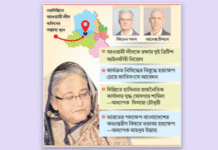
People living in different chars remove whatever they can to safety as water in the River Teesta swells. The photo was taken at Dimla in Nilphamari on Tuesday.
Thousands of people living in different chars and low-lying areas in the country’s northern districts were marooned by floods caused by the on-rush of water from India.
The flood-affected people also started leaving their homesteads for taking shelter on the high lands or embankments as the floodwaters inundated entire low-lying areas on Tuesday.
Flood Forecasting and Warning Centre officials said that the flood situation in the northern districts caused by the on-rush of water from upstream keeping trans-boundary major river systems was likely to deteriorate in the next two or three days.
As the water flows of the Brahmaputra and Jamuna rivers were crossing the danger levels, the flood plains in Kurigram, Sirajganj, Gaibandha, Lalmonirhat, Bogra, Jamalpur and Tangail districts were inundated on Tuesday, they said.
New Age correspondent found that several thousand marooned people from Bagherchars and adjacent areas under Hatibandha upazila in Lalmonirhat and different chars including Charkharibari, Purbagharibari, Uttarghatbari and Tabur Char under Dimla upazila in Nilphamari started leaving for safe destinations by boats.
About 1,500 people from chars took shelter on embankment near Teesta Barrage.
Shukur Ali, 50, who took shelter at the barrage said that he along with 18 member-family took shelter at the high land as his home was flooded.
According to Flood Forecasting and Warning Centre forecast, the Brahmaputra-Jamuna, Ganges-Padma and Surma-Kushiyarariver systems were on
rising trend while flood Situation in Brahmaputra at Chilmari point and Dhaleswari at Elasin poin might deteriorate in the next 48 hours.
Assistant engineer and duty officer of the forecast centre Ripon Karmaker said that the Ganges-Padma river systems might continue to rise in the next 72 hours and there was rainfall in Indian territories.
New Age correspondent in Kurigram reported that floods worsened there as water levels of Brahmaputra and Dharla rivers were rising inundating more areas.
About 55,000 people of over 200 chars of 30 unions under seven upazilas of the district were marooned by the flood as the low-laying char areas of the Brahmaputra and the Dharla rivers were flooded due to downpour and onrush of water from the upstream for the past three days.
About 15,000 people of over 20 villages of nine unions under Sadar and Phulbari upazilas were marooned by floodwater of Dharla river while about 40,000 people of over 110 villages of 21 unions under Sadar, Nageswari, Ulipur, Chilmari, Roumari and Rajibpur upazilas were marooned by floodwater of Brahmaputra, local sources said.
Chairman of Hatia union of Ulipur upazila BM Abul Hossen said, ‘About 1,600 people of 10 villages were marooned by flood of Brahmaputra while they were facing cattle foods and communication problems. Their children cannot to schools due to flood.’
District relief and rehabilitation officer Mottalib Mollah said, ‘Letters have been served to all of nine upazila nirbahi officers to collect data of the flood victims and their affected assets. We expect we will get the information within two days. After receiving data, we will send our demand to the ministry. But we have stock of 100 tonnes of rice and Tk 5 lakh in cash.’
New Age correspondent in Lalmonirhat reported that heavy rains over the past few days and on-rush of water from upstream increased inundating 40 villages in Lalmonirhat. About 20,000 people were marooned.
On Monday evening, Water Development Board decreased water flow from the country’s largest irrigation project Teesta Barrage in the downstream river.
In the past three days, about 44 villages were inundated.
New Age correspondent in Manikganj reported that due to erosion by the river Jamuna, some 500 homesteads of eight villages under Daulatpur upazila were washed away in the past one week.
According to NDTV news, heavy rains have caused floods in 13 districts of Assam, leaving about two lakh people affected a few days ago.
Source: New Age









